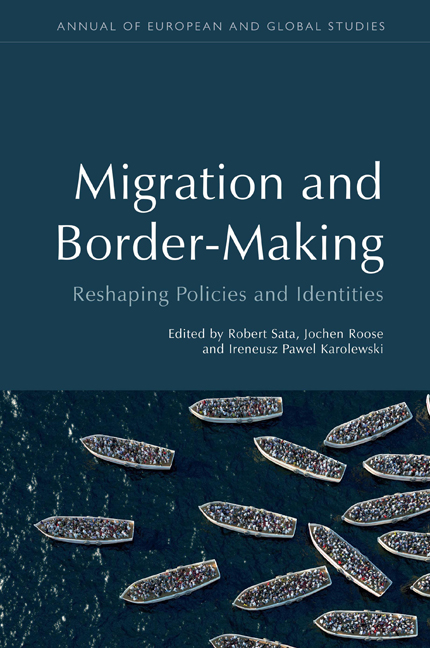Book contents
- Frontmatter
- Contents
- List of Contributors
- Introduction: Patterns and Implications of Migration and Rebordering
- 1 Do Migrants Think Differently about Migration? An Experimentum Crucis for Explaining Attitudes on Migration
- 2 Fencing in the Boundaries of the Community: Migration, Nationalism and Populism in Hungary
- 3 Rethinking Refugee Integration: The Importance of Core Values for Cultural Debate in Germany
- 4 The Unfolding of the Syrian Refugee Crisis in Turkey: From Temporariness to Permanency
- 5 The Middle Eastern Refugee Crisis and the So-Called Islamic State: Motivations of Iraqi Yazidis for Migrating to Europe
- 6 Current Migration Trends in Russia: The Role of the CIS Region Twenty Years after the Collapse of the Soviet Union
- 7 The North Amazon Border: Haitian Flow to Brazil and New Policies
- 8 Macedonian Refugees from the Greek Civil War: From Separation to a Transnational Community
- Index
7 - The North Amazon Border: Haitian Flow to Brazil and New Policies
Published online by Cambridge University Press: 08 October 2020
- Frontmatter
- Contents
- List of Contributors
- Introduction: Patterns and Implications of Migration and Rebordering
- 1 Do Migrants Think Differently about Migration? An Experimentum Crucis for Explaining Attitudes on Migration
- 2 Fencing in the Boundaries of the Community: Migration, Nationalism and Populism in Hungary
- 3 Rethinking Refugee Integration: The Importance of Core Values for Cultural Debate in Germany
- 4 The Unfolding of the Syrian Refugee Crisis in Turkey: From Temporariness to Permanency
- 5 The Middle Eastern Refugee Crisis and the So-Called Islamic State: Motivations of Iraqi Yazidis for Migrating to Europe
- 6 Current Migration Trends in Russia: The Role of the CIS Region Twenty Years after the Collapse of the Soviet Union
- 7 The North Amazon Border: Haitian Flow to Brazil and New Policies
- 8 Macedonian Refugees from the Greek Civil War: From Separation to a Transnational Community
- Index
Summary
Introduction
A globalising world is a world of networks, flows and mobility. It is also a world of borders. (Rumford 2006: 163)
AS CLEARLY STATED by Rumford (2006), the global world can no longer be defined and understood as it was by contemporary social theorists such as Bauman (2000), Appadurai (1996), Castells (1996) and Urry (1999; 2003) in the 1990s. These scholars were emphasising a world in motion, a world composed of motion (Knowles 2017). Bauman shows the world as a ‘liquid modernity’; for Appadurai (1996) and Urry (1999; 2003) the world was best viewed as made up of flows, while Castells (1996) shows a world interconnected through networks. While the world in the global era cannot be framed on the ‘old’ modernity pillars, not all the pillars were totally demolished. In fact, more recently, scholars have started to argue that it is not possible to imagine a borderless and deterritorialised world (Smith and Guarnizo 1998), as the basic ordering of social groups and societies still requires categories and compartments (Harvey 2006). The border emerges, then, as an analytical concept and idea, which has strongly structured social relationships (Ingold 2008).
This chapter, then, intends to understand contemporary borders, on the basis of a case study of the recent migration flow of Haitians to Brazil, from 2010 to 2015. We shed light on how the North Amazon Brazilian border, long forgotten by the Brazilian government, has become a place of negotiation, resilience and, especially, political attention in this decade. Since 2010, Haitians have moved from being a few dozen immigrants in Brazil to become the main immigrant group in the formal labour market in the country in 2013, overtaking the classic migration flows to Brazil, such as the Portuguese (Cavalcanti et al. 2015). The unexpected presence of this migratory flow in the country, mainly through the North Amazon border, has caught the attention of the Brazilian government, resulting in a search for new policies and strategies to ‘control’ and ‘regulate’ this flow and the border (e.g. by creating new regulations and even extending this border beyond its national territory). In this vein, such a phenomenon has also caught our academic attention, as Brazilian migration scholars. We propose in this chapter an analysis of Brazilian migration policy, especially in terms of managing migratory flows and the negotiation of borders.
- Type
- Chapter
- Information
- Transnational Migration and Border-MakingReshaping Policies and Identities, pp. 164 - 188Publisher: Edinburgh University PressPrint publication year: 2020



